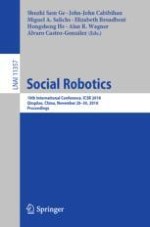2018 | OriginalPaper | Buchkapitel
Reduced Sense of Agency in Human-Robot Interaction
verfasst von : Francesca Ciardo, Davide De Tommaso, Frederike Beyer, Agnieszka Wykowska
Erschienen in: Social Robotics
Aktivieren Sie unsere intelligente Suche, um passende Fachinhalte oder Patente zu finden.
Wählen Sie Textabschnitte aus um mit Künstlicher Intelligenz passenden Patente zu finden. powered by
Markieren Sie Textabschnitte, um KI-gestützt weitere passende Inhalte zu finden. powered by
